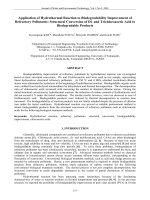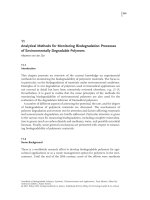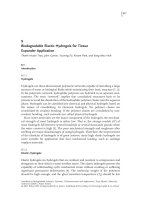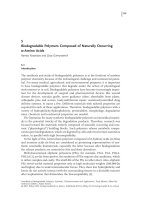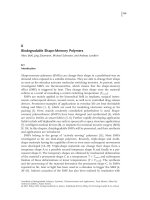Biodegradable Shape-Memory Polymers
Bạn đang xem bản rút gọn của tài liệu. Xem và tải ngay bản đầy đủ của tài liệu tại đây (262.44 KB, 22 trang )
195
Biodegradable Shape - Memory Polymers
Marc Behl , J ö rg Zotzmann , Michael Schroeter , and Andreas Lendlein
8.1
Introduction
Shape - memory polymer s ( SMP s) can change their shape in a predefi ned way on
demand when exposed to a suitable stimulus. They are able to change their shape
as soon as the stimulus activates molecular switching moieties. At present, most
investigated SMPs are thermosensitive, which means that the shape-memory
effect ( SME ) is triggered by heat. They change their shape once the material
softens as a result of exceeding a certain switching temperature ( T
switch
).
SMPs are mainly applied in the biomedical fi eld in implants, surgical instru-
ments, extracorporal devices, wound covers, as well as in controlled drug release
devices. Prominent examples of applications in everyday life are heat shrinkable
tubing and fi lms [1, 2] , which are used for insulating electronic wiring or for
packing [3] . Here, mainly covalently crosslinked polyethylene is used. Shape -
memory polyurethanes (SMPU) have been designed and synthesized [4] , which
are used in textiles as smart fabrics [5, 6] . Further rapidly developing application
fi elds include self - deployable sun sails in spacecraft or space structure applications
[7] , intelligent medical devices [8] , or implants for minimal invasive surgery ( MIS )
[9, 10] . In this chapter, (bio)degradable SMPs will be presented, and their synthesis
and applications are introduced.
SMPs belong to the group of “ actively moving ” polymers [11] . Most SMPs
investigated so far are dual - shape polymers. Recently, triple - shape and multi -
shape materials having the capability of two or even more subsequent movements
were developed [12 – 19] . Triple - shape materials can change their shape from a
temporary shape A to a possible second temporary shape B and fi nally to a per-
manent shape C. The temporary shapes are obtained by mechanical deformation
of the material ’ s permanent shape C at a temperature T > T
switch
and subsequent
fi xation of these deformations at lower temperatures ( T < T
switch
). The synthesis
and the processing of the material determine the permanent shape C. In SMPs
reported so far, heat or light has been used as a stimulus to trigger the SME [4,
20 – 23] . Indirect actuation of the SME has also been realized by irradiation with
Handbook of Biodegradable Polymers: Synthesis, Characterization and Applications, First Edition. Edited by
Andreas Lendlein, Adam Sisson.
© 2011 Wiley-VCH Verlag GmbH & Co. KGaA. Published 2011 by Wiley-VCH Verlag GmbH & Co. KGaA.
8
196
8 Biodegradable Shape-Memory Polymers
infrared - [24] or UV - light [25] , application of electric fi eld [26, 27] or alternating
magnetic fi elds [28 – 31] , or lowering of T
switch
below ambient temperature by plas-
ticizers such as water [32] . The SME results from a combination of a suitable
molecular architecture and a programming procedure. Therefore, intrinsic mate-
rial properties such as thermal or mechanical properties can be adjusted to the
needs of specifi c applications by small variations of molecular parameters, such
as monomer ratio or main chain bonds. This approach of adjusting material
properties enables the design of polymer systems. Furthermore, this approach
enables the creation of multifunctional materials, which is an actual trend in
polymer science. Multifunctionality is the targeted combination of material func-
tions, which are not linked with each other [33] . Multifunctional SMP can be
realized as multimaterial systems, for example, by the incorporation of particles
in polymer matrices, in which each material contributes a certain function, or as
one component systems by the integration of suitable functional groups or build-
ing blocks [34] . Promising approaches can be the combination of biofunctionality,
hydrolytic degradability, and shape - memory functionality. Such multifunctional
SMPs have a high potential for applications in the biomedical fi eld such as MIS
(see Section 8.4 ) [35] . In contrast to metal implants or nondegradable polymers,
bioresorbable SMPs are advantageous as they do not require an additional surgery
for implant removal. In addition, bulky implants created from bioresorbable
SMPs and having a T
switch
between room temperature and body temperature could
be inserted to the application site through a small incision in a compressed or
elongated temporary shape. As soon as the implant is placed in the body, it
assumes body temperature and changes into its bulky application - relevant shape.
Other promising biomedical applications include intelligent degradable suture
materials, which tighten a wound with a predefi ned stress, stimuli - sensitive matri-
ces for drug delivery applications, or active scaffolds for regenerative therapies.
The required bioresorbable SMPs can be realized by the introduction of hydro-
lyzable bonds as weak links in the polymer chain enabling the degradation of these
polymers in the presence of water, which may be supported by enzymes. Figure
8.1 shows hydrolysable bonds used in degradable polymers, in order of their
stability.
Biodegradable, synthetic polymers may have advantages compared to polymers
from natural sources. They can be tailored to meet the specifi c requirements of
certain applications, such as thermal and mechanical properties. In addition, the
processability of synthetic polymers, for example, by extrusion or injection molding
Figure 8.1
Relative stability of chemical bonds against hydrolysis occuring in common,
synthetic polymers.
8.2 General Concept of SMPs
197
is much easier as they display in general a higher thermal stability as natural poly-
mers. The tailoring of the polymer chain length of synthetic polymers enables
polymers to form domains with a more defi ned domain size. When certain precau-
tions are considered, a higher purity can be obtained, as a contamination with
certain cell fragments can be avoided, which originate from the original source
and can act as endotoxins. Consequently, polymers from natural sources require
a high effort of purifi cation, which potentially results in higher costs for such
materials.
8.2
General Concept of SMPs
As the SME results from the combination of the polymer ’ s molecular architecture/
morphology and a specifi c programming procedure, it can be understood as a
functionalization of the polymer. The shape - memory creation procedure (SMCP),
which is also called programming, and the recovery of the original shape due to
the SME are schematically shown in Figure 8.2 .
Suitable polymeric materials that are capable of an SME provide a polymer
network architecture consisting of netpoints, chain segments, and molecular
switches, with the latter being sensitive to an external stimulus, which is heat in
the case of the thermally induced SME.
The permanent shape of the SMP is determined by the netpoints, which are
interconnected by the chain segments. The netpoints can be of chemical (covalent
bonds) or physical (intermolecular interactions) nature. Covalent bonds can be
formed by the application of a suitable crosslinking chemistry, while netpoints
provided by intermolecular interactions require a morphology consisting of at least
two segregated domains, for example, a crystalline and an amorphous phase. In
such multiphase polymers, the polymer chain segments form domains. The
domains that are related to the highest thermal transition temperature ( T
perm
) are
called hard domains and are acting as physical netpoints.
In the course of SMCP when the temporary shape is created, a deformation is
applied to the polymer sample. This deformation requires a suffi cient elastic
Figure 8.2
Schematic representation of the shape - memory effect. Taken from [4] . Copyright
Wiley-VCH Verlag GmbH & Co. KGaA. Reproduced with permission.
198
8 Biodegradable Shape-Memory Polymers
deformability of the polymer network and can be reached by the chain segments,
which must be capable to enable a certain orientation. The extent of the deform-
ability increases with growing length and fl exibility of these chain segments. In
the polymer networks before applying the deformation, the majority of the
polymer chain segments display a random coil conformation, which is the entro-
pically favored orientation. The stimuli - triggered recoiling of the polymer chain
segments, which is entropically driven, enables the recovery of the permanent
shape.
The reversible fi xation of the temporary shape is achieved by stimuli - sensitive
switches that form additional reversible crosslinks, which can be established and
cleaved on demand, and prevent in this way the recoiling of the polymer chain
segments. Similarly to the permanent netpoints, these additional crosslinks can
be established by the formation of chemical (covalent) reversible bonds, by the
intermolecular interactions of side groups, or by the solidifi cation of domains
formed by these polymer chain segments when being cooled below their correlated
thermal transition temperatures T
trans
. Therefore, these polymer chain segments
are also named switching segments; the associated domains are called switching
domains. Such thermosensitive SMP can be classifi ed according to the thermal
transitions related to the solidifi cation of the polymer chain segments. T
trans
can
be a glass transition temperature ( T
g
), a melting transition temperature ( T
m
), or a
liquid crystalline transition. In all cases, heating of the SMP above the thermal
transition causes a regain of fl exibility of the vitrifi ed or crystallized switching
domains so that the elastic state is reached again. In thermoplastic SMP, only the
domains associated to the polymer chain segments with the second highest T
trans
are acting as switching domains.
Figure 8.3 displays a schematic representation of the molecular mechanism of
the thermally induced SME, a thermoplastic SMP with T
trans
= T
m
, and covalent
polymer networks with T
trans
= T
m
(Figure 8.3 b) or T
trans
= T
g
(Figure 8.3 c).
The SME can be quantifi ed in cyclic, stimuli - specifi c tests under strain or stress
control. Many degradable SMPs are triggered by heat as stimulus; consequently,
the SME is determined in cyclic, thermomechanical tests. In these tests, the strain
fi xity rate ( R
f
), the strain recovery rate ( R
r
), and the switching temperature ( T
switch
)
are determined. A single cycle includes the SMCP (programming) and the recov-
ery of its permanent shape. The strain - controlled test consists of four steps: (1)
heating of the sample to a temperature T
high
above T
trans
and deformation of the
sample to a certain extension ( ε
m
) at a defi ned strain rate for a fi xed period of time,
(2) cooling to a temperature T
low
with a certain cooling rate ( β
c
) while ε
m
is kept
constant, (3) unloading of the sample to σ = 0 MPa T
low
, (4) heating of the test
specimen to T
high
while keeping the strain constant, and (5) start of the next cycle
by going back to (1). In this test, the strain applied to the sample is controlled
while the developing stress is recorded. In stress - controlled cyclic tests, steps (1)
and (2) are adapted by keeping the stress σ constant at a maximum stress σ
m
instead of keeping the sample at ε
m
. The recovery step (4) is carried out by keeping
σ = 0 MPa (Figure 8.4 ). In this test protocol, the deformation of the sample is
monitored while the stress is controlled. T
high
and T
low
are adjusted to T
trans
± (20 – 30)
8.2 General Concept of SMPs
199
K of the examined polymer network. These cyclic, thermomechanical tests are
typically performed fi ve times. Figure 8.4 b represents a three - dimensional diagram
of a stress - controlled procedure. While the fi rst cycle is used for erasing the
thermal history of the polymer sample, cycles 2 – 5 are used for quantifi cation of
the shape-memory effect. In such a measurement, the sample is deformed at T
high
to a maximum strain ε
m
resulting in tensile stress σ
m
(maximum stress) (1). The
stretched specimen is then cooled to a temperature T
low
, which is below T
trans
(2).
Several different effects of the sample behavior have to be considered, such as the
Figure 8.3
Schematic representation of the
molecular mechanism of the thermally
induced shape - memory effect: (a) physically
crosslinked polymer network with phase -
segregated domains having a crystalline or
semicrystalline switching phase, (b) covalently
crosslinked polymer network with crystalline
or semicrystalline switching phase, and
(c) covalently crosslinked polymer network
with amorphous switching phase. Taken from
[4] . Copyright Wiley-VCH Verlag GmbH & Co.
KGaA. Reproduced with permission.
200
8 Biodegradable Shape-Memory Polymers
change of the expansion coeffi cient in the vitrifi ed or viscoelastic state or changes
in volume of the sample due to crystallization effects for T
trans
= T
m
[4] . After
cooling, the stress is released ( σ = 0 MPa) leading to the elongation ε
u
(3). Finally,
the sample is heated again to T
high
and the permanent shape ε
p
is recovered (4).
From these cyclic, thermomechanical tests, the values of R
r
and R
f
at a given
strain ε
m
can be determined according to the four equations in Figure 8.5 .
In a strain - controlled protocol, R
f
is given by the ratio of the strain in the stress -
free state after the retraction of the tensile stress in the N th cycle ε
u
( N ) and the
maximum strain ε
m
(Eq. (8.1), Figure 8.5 ). R
f
describes the ability to fi x the
Figure 8.4
(a) ε - σ diagram of the strain -
controlled programming and stress - free
recovery of the shape - memory effect: (1)
deformation of the sample to a maximum
deformation ε
m
at T
high
; (2) cooling to T
low
while σ
m
is kept constant; (3) unloading to
zero stress; (4) clamp distance is driven back
to original starting distance, heating up to
T
high
while keeping σ = 0 MPa; (5) start of
second cycle; (b) ε – T – σ diagram of the
strain - controlled programming and stress - free
recovery of the shape - memory effect: (1)
stretching to ε
m
at T
high
; (2) cooling to T
low
with constant cooling rate while σ
m
is kept
constant; (3) clamp distance is reduced until
the stress - free state σ = 0 MPa is reached; (4)
heating to T
high
with a constant heating rate;
and (5) start of the second cycle [4] . Taken
from [4] . Copyright Wiley-VCH Verlag GmbH
& Co. KGaA. Reproduced with permission.
a) b)
Figure 8.5
Equations for the determination of R
f
and R
r
from cyclic, thermomechanical
measurements.
strain-controlled stress-controlled
Shape fixity ratio (R
f
)
m
u
f
N
NR
ε
ε
)(
)( =
)(
)(
)(
N
N
NR
l
u
f
ε
ε
=
Shape recovery ratio (R
r
)
)1(
)(
)(
−−
−
=
N
N
NR
pm
pm
r
εε
εε
)1()(
)()(
)(
−−
−
=
NN
NN
NR
pl
pl
r
εε
εε
(8.1)
(8.2) (8.4)
(8.3)
8.3 Classes of Degradable SMPs
201
mechanical deformation, which has been applied during the programming
process. R
r
quantifi es the ability of the polymer to memorize its permanent shape
and it is a measure of how far the applied strain during the programming
ε
m
− ε
p
( N − 1) is recovered during the SME. For that the strain that was applied
during the programming in the N th cycle, ε
m
− ε
p
( N − 1) is compared to the
change in strain during the SME ε
m
− ε
p
( N ) (Eq. (8.2), Figure 8.5 ). The remaining
strain of the samples after two successively passed cycles in the stress - free state is
given by ε
p
( N − 1) and ε
p
( N ). In the stress - controlled protocol, R
f
is represented by
the ratio of the tensile strain after unloading ε
u
and the strain at σ
m
after cooling
of the N th cycle ε
l
( N ) (Eq. (8.3), Figure 8.5 ). In such a protocol, R
r
quantifi es the
ability of the polymer to reverse the deformation that was applied in the program-
ming procedure ε
l
− ε
p
( N − 1) during the following shape - memory transition. For
this purpose, the strain that was applied during the programming step in the N th
cycle ε
l
( N ) − ε
p
( N − 1) is compared to the change of strain that occurs with the
SME ε
l
( N ) − ε
p
( N ) (Eq. (8.4), Figure 8.5 ).
8.3
Classes of Degradable SMP s
A strategy to functionalize SMP, so that they become biodegradable is the intro-
duction of hydrolytically cleavable bonds into such polymers (see Figure 8.1 ) [36] .
In the design of these polymers, it has to be considered that the degradation
products should be either fully metabolized or excretable as fragments. This is of
exceptional importance when these SMP are intended for biomedical applications.
Furthermore, such degradable polymeric (bio)materials enable the application as
matrix materials for controlled drug release systems that requires the exact char-
acterization of the polymer ’ s erosion behavior and the drug diffusion characteris-
tics. Degradable SMPs show two types of degradation mechanisms: surface - and
bulk erosion [37] . The degradation type depends on the diffusion of water into the
polymer and the reactivity of the polymer functional groups (see Figure 8.1 ).
Amorphous and crystalline segments, especially switching segments, display dif-
ferent degradation behavior. Amorphous segments degrade much faster due to
the easier water penetration in these areas. In contrast, the penetration of water
in crystalline segments is more inhibited by the dense packing of the crystalline
lamellae.
In this section, an overview about degradable materials that exhibit an SME is
given. SMPs can be divided into four types (see Table 8.1 ).
The requirements for an implant material are determined by the specifi c appli-
cation. The key properties of degradable biomaterials are their mechanical proper-
ties, their degradation rate and degradation behavior, as well as biocompatibility
and biofunctionality. Each application requires a specifi c combination of these
properties/functions.
In the following sections, four different types of degradable SMPs are described.
202
8 Biodegradable Shape-Memory Polymers
8.3.1
Covalent Networks with Crystallizable Switching Domains, T
trans
= T
m
This type of polymer network consists of chain segments of homo - or copolymers
and covalent netpoints. They can be prepared by (co)polymerization/poly(co)con-
densation of several monomers (Figure 8.6 ).
As a linear polyester poly( ε - caprolactone) ( PCL ) is hydrolytic degradable. It can
be synthesized by ring - opening polymerization (ROP) of ε - caprolactone. When
diols are used as initiators, macrodiols can be obtained. Covalent polymer net-
works can be created from these macrodiols after subsequent functionalization
with polymerizable end groups, for example, dimethacrylates. These polymer
networks were shown to be hydrolytically degradable and capable of an SME [38] .
By the addition of a comonomer, for example, n - butyl acrylate, the elasticity of
such polymer networks can be increased, resulting in AB copolymer networks. At
the same time, T
trans
of the network can be adjusted from 51 ° C for the PCL dimeth-
acrylate homonetwork to 44 ° C for a copolymer network having 70 wt% n - butyl
acrylate [41] . The degradability of such AB copolymer networks could be increased
by the introduction of glycolide into the macrodimethacrylates [42] . The AB copoly-
mers were prepared from poly( ε - caprolactone - co - glycolide) dimethacrylate and n -
butyl acrylate as photosets. The macrodimethacrylates had a number average
molecular weight ( M
n
) up to 13,500 g mol
− 1
and a maximum glycolide content of
21 mol%. The polymers were semicrystalline at room temperature and displayed
a T
m
between 18 and 53 ° C. In the polymer networks, the oligo(butyl acrylate)
formed the amorphous soft segment. Degradation experiments showed good
hydrolytic degradability at pH 7 and 37 ° C. The presence of glycolate accelerates
Table 8.1
Overview over the four categories of SMP .
Type of netpoints
of polymer network
Switching
domains
Thermal
transition
Example
Covalent Crystallizable T
m
Polymer networks from
poly( ε - caprolactone)
dimethacrylate [38]
Covalent Amorphous, not
crystallizable
T
g
Polymer networks from
oligo[( rac - lactide) - co - glycolide]
tetrol and diisocyanate [39]
Physical Crystallizable T
m
Polymer networks from
oligo( ε - caprolactone)diole,
oligo( p - dioxanone)diole and
diisocyanate [9]
Physical Amorphous, not
crystallizable
T
g
Poly( l , l - lactide - co - glycolide - co -
trimethylene carbonate) [40]

